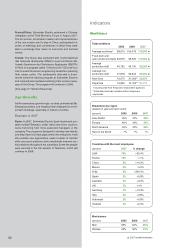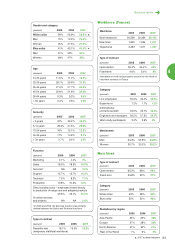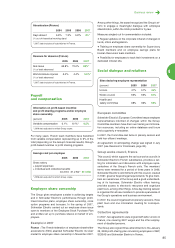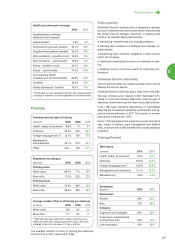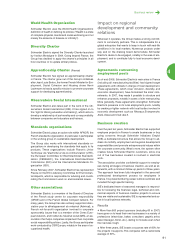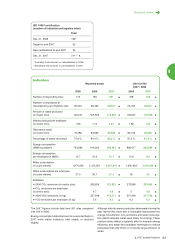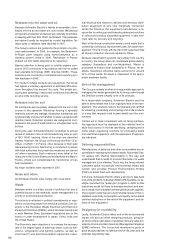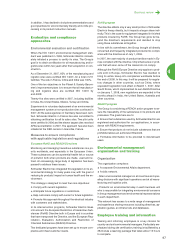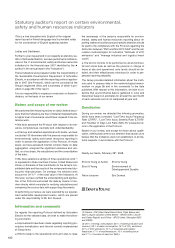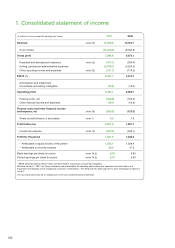APC 2007 Annual Report Download - page 94
Download and view the complete annual report
Please find page 94 of the 2007 APC annual report below. You can navigate through the pages in the report by either clicking on the pages listed below, or by using the keyword search tool below to find specific information within the annual report.
92
In all, 1,200 jobs have been created, as each new busi-
ness has generated two jobs on average.
Youth opportunities
Schneider Electric has been involved in helping young
people enter the workforce for many years. Team mem-
bers' involvement in these programs has been a key suc-
cess factor. In each host country, the Group looks for the
most effective way to make a difference, from apprentice-
ships and partnerships with schools and associations to fi-
nancial support for young students and participation in
technical or general training courses. These programs
dovetail with the partnerships forged through the Schneider
Electric Foundation (see Community page 90).
Examples in 2007
In France, the annual "100 opportunities – 100 jobs" cam-
paign targets, by employment basin, 100 low-skilled resi-
dents of depressed neighborhoods, aged 18 to 30, who
are motivated to take part in a job opportunity program.
The objective is to open the door to long-term employment
within a period of 36 months by offering personalized skills-
qualification paths with the help of 30 companies brought
together and led by Schneider Electric. A positive outcome
target of 60% has been set, meaning that participants ob-
tain a fixed-term contract of more than six months, an
open-ended contract or a skills-qualification training con-
tract.
The French government launched the first "100 opportuni-
ties – 100 jobs" campaign in January 2005 in Chalon sur
Saône, in partnership with Schneider Electric subsidiary
SFG (2005-2007).
Results:
Chalon sur Saône (after three years)
Of the 121 participants, 62 (or 51%) obtained an open-
ended contract, 14 (or 12%) received support in their job
searches and 44 (37%) left the program before it ended.
Grenoble (after two years)
Of the 79 participants, 34 (or 43%) obtained an open-
ended contract, 25 (or 32%) received support in their job
searches and 20 (25%) left the program before it ended.
In addition, 256 young people attended an encounter or-
ganized in a Grenoble neighborhood that led to 494 job in-
terviews with 21 companies and 28 three-month contracts.
The "100 opportunities – 100 jobs" campaign was de-
ployed in Normandy in 2007.
Innovation
To prepare the solutions of the future, Schneider Electric
devotes more than 4% of its revenue to R&D. In 2005, the
Group set up a scientific council to provide guidance on the
ongoing evolution of science, technology and innovation. In
particular, the council is responsible for understanding the
Group’s approaches and making recommendations in the
following areas:
Scientific and technical policy governing products, prod-
uct development, manufacturing, services, etc., notably as
concerns emerging technologies and/or technologies from
other industries that could have an impact on Schneider
Electric’s businesses.
Research and innovation program management (inno-
vation practices, scientific and technical cooperation,
patent strategy, international deployment, customer in-
volvement, suppliers, etc.).
The Group’s global competencies strategy.
Schneider Electric focuses a large part of its research on
energy efficiency. In medium voltage, it is doing work on
new sensors and software to give devices advanced diag-
nostic functions. Group teams are also designing new elec-
trical distribution products to feed energy from solar power,
micro-turbines, wind farms or fuel cells into the power grid.
Environmental
performance
Schneider Electric fully assumes its environmental re-
sponsibility in its businesses by participating in the defi-
nition of new regulations and applying them early, by
making sites more energy efficient, by promoting eco-de-
sign, and by raising employees’ and partners’ environ-
mental awareness.
Framework
Schneider Electric neither generates nor distributes elec-
tricity. Its business primarily relies on assembly and moni-
toring techniques and includes very few processes with a
more significant environmental impact, such as metal pro-
cessing and treatment.
The Group has 211 manufacturing facilities.
It is committed to including all units in the scope of report-
ing. In 2005, environmental reporting was expanded from
manufacturing sites to logistics facilities. The number of
units covered grew to 201 in 2007 from 184 in 2006 and
172 in 2005, despite site closures and consolidation during
the year.
The Group’s environmental reporting principles were offi-
cially audited in early 2006, early 2007 and at the end of
2007.
Improvement plans -
Planet & Society Barometer
Sites
Ensure that all manufacturing and logistics sites
are certified ISO 14001.
2005 2006 2007
Customers
Provide an environmental profile for
120 products representing more than 50% of total
product revenue.
2005 2006 2007
Energy efficiency
Reduce energy consumption per production site
employee by 10%.
2005 2006 2007
Rating 6.7/10 7.5/10 10/10
Rating 2.3/10 5.4/10 8.1/10
Rating 5/10 6.86/10 5.03/10


